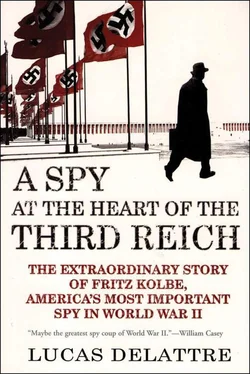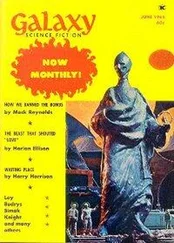Berlin, late August 1943
Back in Berlin on Saturday, August 21, 1943, Fritz was greeted by one of the most terrible bombardments that the capital of the Reich had ever experienced. Between August 20 and 23, the Charlottenburg, Steglitz, and especially Lankwitz neighborhoods were very heavily damaged. Sunday evening, he was in fact in Lankwitz at his friend Walter Girgner’s when a huge roar of engines was heard: It was the RAF planes. Fritz was in the middle of recounting his trip to Bern and his meeting with the Americans. Also present was Hans Kolbe, Fritz’s only brother.
There was a deluge of bombs. None of the three friends had ever experienced anything like it. Like all Berliners, they could recognize by sound the different types of bomb (explosive or incendiary). But now they didn’t have the time to indulge in that exercise. Suddenly, lightning seemed to be striking them. The entire neighborhood seemed to be sinking beneath the earth in a deluge of fire. The two houses adjacent to Girgner’s were hit before their eyes. The three men took refuge in the cellar. At five in the morning, when the planes had left, Fritz and his friends came out of their hole and were stunned to see that an explosive bomb that had fallen very close to Girgner’s house had not detonated. They had had a narrow escape. The Lankwitz neighborhood was destroyed.
Fritz went home on foot, passing through scenes of desolation, amid the cries of survivors and the heat of burning ruins. The rescue services were overwhelmed by events. He took more than an hour to get back to the Kurfürstendamm, not knowing whether the house he lived in was still standing. Gott sei Dank, he said to himself when he got there. The building was still there, and most important, there was still running water on every floor. He quickly took a cold shower and went to the ministry at nine o’clock.
That same morning, his friend Karl Dumont came to see him in his office. Speaking in a low voice, he wanted to know everything about the trip to Switzerland. Of all Fritz’s colleagues in the Foreign Ministry, Dumont was the only one who was aware of Fritz’s real intentions. Since they had known one another in Madrid, there had been perfect rapport between the two men. Dumont had been absent because of illness the week before. He thought that his friend had failed and was ready to bury him in reproaches. At the moment, Fritz could not tell him the details of his trip, but he met him again in the late afternoon, at a time when the offices were already largely deserted, to give him a detailed report of his visit to Bern.
Bern, September 1943
By early September 1943, Allen Dulles had completed the first phase of his investigation of Fritz Kolbe. He had not yet eliminated the theory that it was a trap. He was waiting to see whether and how his informant would show himself again. It was a letter addressed to Ernst Kocherthaler, written in Berlin on September 16, 1943, that revealed that Fritz had not said his last.
The letter contained reading material for the Americans: a few copies of cables, a new map of Hitler’s headquarters (the same as in August, with a few errors corrected), and the schedule for the daily train between Berlin and Rastenburg, the “wolf’s lair” in East Prussia. It also contained a few details about the results of the Allied bombardment of the ball bearing factory in Schweinfurt a few weeks earlier. Fritz took the liberty of suggesting other targets and provided a personal opinion about German secret weapons, which he erroneously claimed was “the greatest bluff ever practiced on the German people.”
At the end of his letter, Fritz had hastily scribbled a few words in his unreadable handwriting: “I write these lines in wild haste, scanning the material with one eye and typing it with the other hand.” In conclusion, he took leave of his readers in Bern by sending them “greetings from Hektor” (an allusion to the Abwehr agent based in Stockholm), and signed “George M.,” for “George Merz,” the provisional pseudonym adopted during his August visit.
How had this message reached Bern? Mystery. Given its content, it could not have gone through ordinary mail. It was probably mailed in Bern by a colleague of Fritz’s carrying the diplomatic pouch—a routine expedition that took place every week, exactly like the one Fritz had made in August. Every time a diplomat went abroad for a mission of this kind, he took out and brought back dozens and dozens of private letters and packages having nothing to do with his professional duties. These packages were placed in the train’s baggage compartment, were entitled to diplomatic immunity, and were not checked at the border. From Germany to Switzerland, people sent books, radios, phonographs… It is probable that if Fritz Kolbe had given a personal letter to a colleague on assignment to Bern, the “mailman” was totally ignorant of its contents.
Another hypothesis can be suggested: Fritz knew a trustworthy person who, because he was a surgeon, could easily travel between Berlin, annexed Alsace, and sometimes even Switzerland. This was Albert Bur, a friend of Adolphe Jung’s, former chief surgeon of the hospital of Sélestat, dismissed in late 1941 for being a “Francophile.” Albert Bur lived in Obernai (Ober-Ehnheim in German). He was a specialist in photography and devoted a good deal of time to the emerging technique of color photography and its medical applications. In this connection, he frequented chemical industry circles, particularly the Agfa company. Fritz had naturally gotten on well with him. The two men shared a passion for sports: before the war, Bur had been president of the Sport Club of Sélestat.
Doctor Bur was prepared to take risks for the Allied cause. He was in contact with French Resistance circles and with British agents active in France. His wife was an American born in Chicago. He naturally became an intermediary for Fritz in order to transmit information, in particular about “Josephine,” and even tried to convince him to travel secretly to London. This was too dangerous, in Fritz’s judgment, but he nevertheless decided to involve his friend closely in his plans. Thanks to his frequent travels, Albert Bur was a rare jewel.
Bern, October 1943
On October 10, 1943, the OSS in London received a mysterious telegram from Bern: Allen Dulles cabled cryptically that he “had just got some 200 pages of alpha and since they were no longer sure of beta, it would take weeks to handle. [He was] fully convinced of delta after yesterday’s gamma and from internal evidence.” The key to this strange message was not received in London until the following day. It was revealed that alpha meant German two-way secret Foreign Ministry cables, beta meant the security of the communications channel, and delta the particular value and authoritative quality of this material. Finally, gamma meant Wood’s cross-examination.
Fritz Kolbe had arrived in Bern a few days earlier in the course of a new assignment as diplomatic courier. Fräulein von Heimerdinger had shown herself very capable in securing this second mission for her protégé. The small gifts brought back from Bern in August may have facilitated matters. A cigar here, a box of chocolates there; Fritz Kolbe had been generous. Why not do him a favor and let him breathe a little bit abroad? In Berlin in October 1943 it was impossible even to pretend to live normally. The bombardment by Allied planes was added to the increasing harshness of the regime. There was not only the constant fear of bombardment hanging over everything, but the slightest misstep could send you to the gallows. How many people had already been executed for making “defeatist” statements?
Читать дальше











